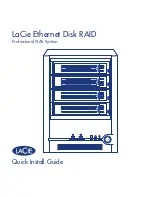
a Select the
Storage
tab.
b In the
Storage
tab navigation pane, select the
Disks
node.
c On the
Disks
tab, record the number of drives that are accessible by the Storage Center.
Compare this value to the number of drives accessible by the Storage Center after adding expansion enclosures to the storage
system.
4
Click the
Hardware
tab and select the
Enclosures
node in the Hardware tab navigation pane.
5
Click
Add Enclosure
. The
Add New Enclosure
wizard starts.
a Click
Next
to validate the existing cabling.
b Select the expansion enclosure type and click
Next
.
c If the drives are not installed, install the drives in the expansion enclosures.
d Turn on the expansion enclosure. When the drives spin up, make sure that the front panel and power status LEDs show normal
operation.
e Click
Next
.
f
Add the expansion enclosure to the A-side chain. Click
Next
to validate the cabling.
g Add the expansion enclosure to the B-side chain. Click
Next
to validate the cabling.
h Click
Finish
.
6
To manually manage new unassigned drives:
a Click the
Storage
tab.
b In the
Storage
tab navigation pane, select the
Disks
node.
c Click
Manage Unassigned Disks
.
The
Manage Unassigned Disks
dialog box opens.
d From the
Disk Folder
drop-down menu, select the drive folder for the unassigned drives.
e Select
Perform RAID rebalance immediately
.
f
Click
OK
.
7
Label the back-end cables.
Add the SCv300 and SCv320 Expansion Enclosures to the A-
Side of the Chain
Connect the expansion enclosures to one side of the chain at a time to maintain drive availability.
1
Cable the expansion enclosures to the A-side of the chain.
a Connect a SAS cable from storage controller 1: port 1 to the first expansion enclosure in the chain, top EMM, port 1.
b Connect a SAS cable from storage controller 2: port 2 to the last expansion enclosure in the chain, top EMM, port 2.
72
Adding or Removing Expansion Enclosures
















































